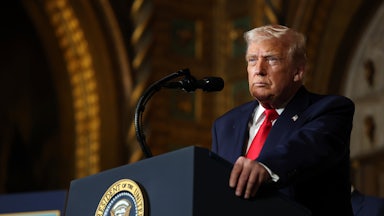Trump’s latest proposal to expel asylum-seekers to the tiny Pacific island nation of Palau continues the pattern of performative cruelty already well established by the illegal deportations, the establishment of a grifty concentration camp on American soil, the declaration that people previously granted legal entry are no longer entitled to be here, the grotesque mistreatment of foreign visitors and former aides to the U.S. military, and other outrageous actions by the present administration. It is already evident that Trump’s interlocking immigration schemes will drive up inflation in the United States and reduce economic output. In spite of Trump’s vow to go after “the worst of the worst,” most of those being deported and incarcerated have never been accused of any crime in the U.S. or elsewhere. Meanwhile, the need for a genuine, long-term policy to deal with immigration, asylum, and the existing undocumented population goes almost entirely unmet. So what is really behind the needless and public exercises in sadism that pass for immigration policy?
The short answer is a version of the “great replacement theory”: the idea that immigration is part of a deliberate plot to destroy the United States by replacing “real” or “true” Americans with aliens. The point of Trump’s immigration policies is to satisfy the desire, on the part of Trump’s base as well as nativist ideologues in his administration, to see pain inflicted on undesirables and their supposedly malevolent supporters—liberals, “the woke”—within the country.
The great replacement theory and its variants have a long history, and they have always been in the wrong. The nineteenth-century physician Horatio Robinson Storer, an early anti-abortion campaigner, lamented that “abortions are infinitely more frequent among Protestant women than among Catholic” and wondered whether America’s western and southern territories would be “filled with our own children or by those of aliens?” The sociologist and eugenicist Edward Alsworth Ross argued that Japanese immigrants should be banned from entering the country and coined the term “race suicide.” In Charlottesville in 2017, the neo-Nazi crowd chanted, “The Jews will not replace us.”
But this idea does have a polite version, an intellectualized variant, articulated at the kind of think-tank gatherings where people in suits and ties with advanced degrees from highly respected institutions can pretend that their dehumanizing and racist ideology is not, in fact, dehumanizing and racist.
By virtue of his Yale law degree and his apparent desire to make the “intellectual” case for a corrupt, kleptocratic, cronyist regime based on nationalist demagoguery and unhinged conspiracism, JD Vance has now presented himself as an exponent of the “thoughtful” version of replacement theory that now underpins the immigration policies of the present government.
In his speech accepting the vice presidential nomination, JD Vance casually sidelined the ideas articulated in the Declaration of Independence and the Gettysburg Address: that the United States is a nation dedicated to the proposition that all people are created equal. The purpose of America, he suggested, doesn’t have much to do with inalienable rights, or the right of people to govern themselves.
Rather, said our vice president, America “is a group of people with a shared history and a common future. It is, in short, a nation.” At the Claremont Institute, he made the point even clearer. American identity as “purely an idea,” he said, is “the logic of America as a purely creedal nation” and would “reject a lot of people that the [Anti-Defamation League] would label as domestic extremists, even though those very Americans had their ancestors fight in the Revolutionary War and the Civil War.”
America’s Founders, he further argued in his Claremont speech, understood “that our shared qualities, our heritage, our values, our manners and customs confer a special and indispensable advantage.” “Social bonds form among people who have something in common,” he added, “They share the same neighborhood. They share the same church.”
Vance is using a sleight of hand here. Of course social bonds form when people share things in common! Of course a nation consists of a group of people with a shared history and future! Those are just truisms. They say nothing about how we define the purpose and meaning of America. Maybe some other countries can define themselves according to the church their grandparents attended—but that’s not the America that Lincoln and Jefferson, among countless others, established. We the people have agreed to promote the general welfare not by conducting a survey of the views of some subset of ancestors who happened to be present at the Civil War, but by making laws through representative government based on the idea that all people are free and equal before the law.
Vance is a clever ideologue—Yale must count for something—and so he includes a pro forma nod to those who “gave their life to build the kind of society where his family can escape racial theft and racial violence.” But those people who gave their lives on the pro-slavery side of the Civil War, along with a great number of the people attending JD Vance–approved churches today—the same people that Mr. Vance says have a “helluva lot more claim to be American” than any recent immigrants—were in fact fighting to promote racial theft and violence.
To get an idea of what Vance’s version of the great replacement ideology looks like in practice, you need only look at the Department of Homeland Security’s Twitter feed. In one post, the words “Remember your Homeland’s Heritage” appear above a painting, titled New Life in a New Land, by Morgan Wistling, of a young family in a covered wagon; in another post, the words “Heritage to be proud of, a Homeland worth defending” appear above the Manifest Destiny–themed painting American Progress by John Gast. Most of the rest are images of people of color whom they identify as criminals.
Versions of the Vance ideology show up throughout American history, and it has always been for the same malicious intent: to divide the “real” Americans from the ones who don’t belong.
The intent becomes clear the moment you ask the speaker who the “real” Americans are. Are they the descendants of the Mayflower? That’s just silly; those descendants would have represented a tiny minority even at the time of the American Revolution. Are the real Americans white? That’s not just racist but stupid; most Black Americans today have ancestors who lived in America significantly longer, on average, than white Americans, and their contributions to American culture and identity are immeasurable.
Would the real Americans be Christian? Consider that many Protestants in the early republic vehemently condemned the religion of America’s other Christian sects and would have viewed the quarter of the American population that identifies as Catholic as fake Christians. Are Latinos really American? Much of the Southwest, along with California, belonged to Mexico until 1848—and the largely white settlers coming from the existing states were the immigrants.
One story that these reactionary nativists tell is: Sure, there were different immigrant groups that originated in Europe and elsewhere, but somehow the “good” ones assimilated and became honorary members of the white Christian Pilgrim tribe. But that isn’t the way it happened at all.
When outsiders came in, pretty much wherever they came from, nativists greeted them with contempt. In the late nineteenth century and beyond, members of the Pennsylvania Dutch, for example, experienced rampant discrimination. Irish immigrants encountered employment ads that read, “No Irish need apply.” The early and mid-nineteenth century was marked by deadly anti-immigrant riots. The Southern and Eastern Europeans who poured in during this period were generally not considered “white.”
Later, when their descendants decided that they were white after all, what this really meant is that they were not Black. It did not mean that they had become copies of the Pilgrim tribe. On the contrary, American culture diversified and flourished.
The Know-Nothings were also keen on keeping “un-American” groups out—which would have meant keeping all those Catholics out of JD Vance’s home state of Ohio. The America Firsters of the 1930s liked the Nazi idea of keeping American racially pure—which is why the Nazis in Germany loved them back.
As a rule, the movements that rely on the great replacement theory and its variants involve an unhealthy dynamic between two distinct groups in society. To put it simply, it’s a story that a small number of big people push on a large number of little people to convince them that there is something in the system that works for them. Consider that all the riches of the slave system were concentrated in the hands of a tiny slaveholding elite, but the impoverished white majority could at least bask in the illusion that they belonged to a superior racial group. The stakes are very different now, but the process is still the same. Essentially, nearly all the benefits of the Trumpian economic policy will fall into the hands of a tiny financial elite, but the broad mass of Trump supporters can find happiness in the illusion that they will not be replaced by some inferior group—or at least they will be expected to do so.
It is not necessary for the elites who propound the noxious, anti-American ideology of the great replacement to actually believe in it for this kind of counterrevolutionary movement to flourish. They just need a critical mass of people in their thrall to believe in it. It should be noted here that Vance is married to a second-generation Indian American. Since she, along with her parents and his children, presumably share just a little bit less of our blessed American history, one has to wonder if he also draws the necessary inference that they are less American than he is.
We can’t know what’s in JD Vance’s heart. What matters is that he seems to believe that, to keep himself and his associates in power, the U.S. government needs to ship asylum-seekers off to random islands and engage in an ever-expanding menu of sadistic acts. Meanwhile, none of our actual immigration issues are resolved and the rest of us are simply forced to pay the price. Our rights are eroded, our economy is damaged, and our culture diminished—all to keep a corrupt regime in power and fund a massive welfare program for the cronies running America’s very own gulag archipelago.










